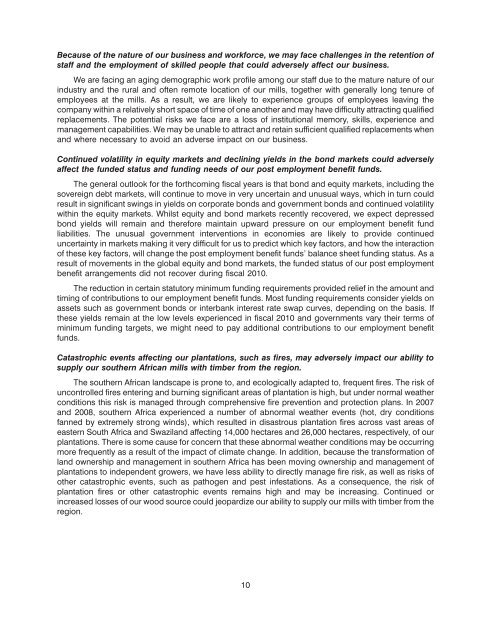Create successful ePaper yourself
Turn your PDF publications into a flip-book with our unique Google optimized e-Paper software.
Because of the nature of our business and workforce, we may face challenges in the retention of<br />
staff and the employment of skilled people that could adversely affect our business.<br />
We are facing an aging demographic work profile among our staff due to the mature nature of our<br />
industry and the rural and often remote location of our mills, together with generally long tenure of<br />
employees at the mills. As a result, we are likely to experience groups of employees leaving the<br />
company within a relatively short space of time of one another and may have difficulty attracting qualified<br />
replacements. The potential risks we face are a loss of institutional memory, skills, experience and<br />
management capabilities. We may be unable to attract and retain sufficient qualified replacements when<br />
and where necessary to avoid an adverse impact on our business.<br />
Continued volatility in equity markets and declining yields in the bond markets could adversely<br />
affect the funded status and funding needs of our post employment benefit funds.<br />
The general outlook for the forthcoming fiscal years is that bond and equity markets, including the<br />
sovereign debt markets, will continue to move in very uncertain and unusual ways, which in turn could<br />
result in significant swings in yields on corporate bonds and government bonds and continued volatility<br />
within the equity markets. Whilst equity and bond markets recently recovered, we expect depressed<br />
bond yields will remain and therefore maintain upward pressure on our employment benefit fund<br />
liabilities. The unusual government interventions in economies are likely to provide continued<br />
uncertainty in markets making it very difficult for us to predict which key factors, and how the interaction<br />
of these key factors, will change the post employment benefit funds’ balance sheet funding status. As a<br />
result of movements in the global equity and bond markets, the funded status of our post employment<br />
benefit arrangements did not recover during fiscal 2010.<br />
The reduction in certain statutory minimum funding requirements provided relief in the amount and<br />
timing of contributions to our employment benefit funds. Most funding requirements consider yields on<br />
assets such as government bonds or interbank interest rate swap curves, depending on the basis. If<br />
these yields remain at the low levels experienced in fiscal 2010 and governments vary their terms of<br />
minimum funding targets, we might need to pay additional contributions to our employment benefit<br />
funds.<br />
Catastrophic events affecting our plantations, such as fires, may adversely impact our ability to<br />
supply our southern African mills with timber from the region.<br />
The southern African landscape is prone to, and ecologically adapted to, frequent fires. The risk of<br />
uncontrolled fires entering and burning significant areas of plantation is high, but under normal weather<br />
conditions this risk is managed through comprehensive fire prevention and protection plans. In 2007<br />
and 2008, southern Africa experienced a number of abnormal weather events (hot, dry conditions<br />
fanned by extremely strong winds), which resulted in disastrous plantation fires across vast areas of<br />
eastern South Africa and Swaziland affecting 14,000 hectares and 26,000 hectares, respectively, of our<br />
plantations. There is some cause for concern that these abnormal weather conditions may be occurring<br />
more frequently as a result of the impact of climate change. In addition, because the transformation of<br />
land ownership and management in southern Africa has been moving ownership and management of<br />
plantations to independent growers, we have less ability to directly manage fire risk, as well as risks of<br />
other catastrophic events, such as pathogen and pest infestations. As a consequence, the risk of<br />
plantation fires or other catastrophic events remains high and may be increasing. Continued or<br />
increased losses of our wood source could jeopardize our ability to supply our mills with timber from the<br />
region.<br />
10
















